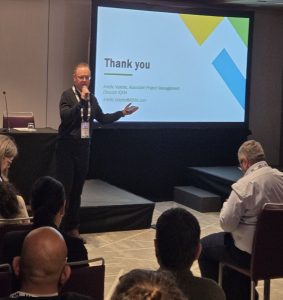This year has been packed with conferences, and we’ve recently closed out the latest: SCOPE Europe in Barcelona. The breakout agenda at SCOPE was strong, with timely topics and presenters who reminded us that great content is most effective when it’s paired with thoughtful delivery.
The way clinical trial communication is shared can determine whether a message lands or gets lost. When a room goes quiet, it should be because people are engaged and not tuning out.
A reconnection at SCOPE brought that idea into sharp focus.
Delivery Is As Important As Content
I’m sure this happens to you: for the third conference in a row, I crossed paths with a former colleague. As we caught up and swapped stories, she surprised me with a memory from a PI meeting almost 10 years ago in San Diego, where a colleague and I gave a presentation using a game show theme.
She still remembered it and called it the best presentation she’s ever seen at an investigator meeting. She said she wished more industry sessions had that level of creativity and energy.
Her comment really resonated with me. At conferences, time is tight. People are juggling packed agendas, jet lag, and not enough sleep. It can be stressful. Participants have limited windows to choose which breakout sessions to attend, and they hope to walk away with something useful. They deserve to be impressed.
The best speakers get that. They bring energy, tell stories, and make the room feel like part of the conversation. And just as importantly, they know what to avoid:
- Reading straight from slides: Slides support what you have to say. They aren’t your script.
- Speaking in a monotone: Delivery matters.
- Delivering content without context: Give people a reason to care.
The core principle of doing it right is knowing and respecting the audience.
Clinical Trial Communication: Audience First

Dan McDonald, Imperial VP of business development, facilitates the small biopharma track at SCOPE Europe.
That core principle of clinical trial communication applies to conference stages as well as patient-facing websites, printed brochures, and every other format used to communicate in clinical research.
There are many ways to deliver a message, and the same rule applies: if you want people to engage, you must zero in on what they care about, how they process information, and what tone will capture their attention. And you don’t want to waste their time.
A patient website or brochure isn’t just about adherence to the study protocol. It’s about empathy, clarity, and tone. Materials for site staff need to be respectful of time and easy to navigate. (More than once, we’ve seen site staff get excited receiving mini protocols with tabs!)
After years of supporting clinical trials across countless therapeutic areas, we’ve seen what works. Every project is important, and the goal remains the same: to deliver with purpose, connect with clarity, and make every moment count.
The Imperial Advantage
If your study needs materials that inform, engage, and respect your audience, we’re ready to help.
At Imperial, we understand that great clinical trial communication isn’t just about what you say—it’s about how, when, and to whom you say it. We create every piece with purpose. We know how to shape messages that resonate across audiences, formats, and timelines.
Click the Contact Us button or visit our website to learn more.

